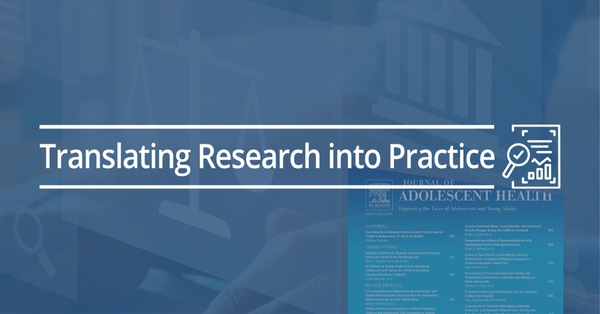Featured Article
Article Title
Loneliness During Adolescence and Subsequent Health and WellBeing in Adulthood: An Outcome-Wide Longitudinal Approach
Authors
Eric S. Kim, Ph.D; Department of Psychology, University of British Columbia, Vancouver, British Columbia, Canada; Human Flourishing Program, Institute for Quantitative Social Science, Harvard University, Cambridge, Massachusetts; Lee Kum Sheung Center for Health and Happiness, Harvard T.H. Chan School of Public Health, Boston, Massachusetts
Renae Wilkinson, Ph.D; Human Flourishing Program, Institute for Quantitative Social Science, Harvard University, Cambridge, Massachusetts
Julianne Holt-Lunstad, Ph.D; Department of Psychology, Brigham Young University, Provo, Utah
Tyler J. VanderWeele, Ph.D; Human Flourishing Program, Institute for Quantitative Social Science, Harvard University, Cambridge, Massachusetts; Department of Epidemiology, Harvard T.H. Chan School of Public Health, Boston, Massachusetts; Department of Biostatistics, Harvard T.H. Chan School of Public Health, Boston, Massachusetts
Abstract
Purpose: Intergovernmental organizations, such as the World Health Organization, policymakers, scientists, and the public alike are recognizing the importance of loneliness for health/well-being outcomes. However, it remains unclear if loneliness in adolescence shapes health/well-being in adulthood. We examined if increase in loneliness during adolescence was associated with worse health/well-being in adulthood, across 41 outcomes.
Methods: We conducted a longitudinal study using data from Add Healthda prospective and nationally representative cohort of community-dwelling U.S. adolescents. Using regression models, we evaluated if an increase in loneliness over 1 year (between Wave I, 1994-1995 and Wave II, 1996) was associated with worse health/well-being outcomes 11.37 years later (in Wave IV, 2008; N ¼ 11,040) or 20.64 years later (in Wave V, 2016-2018; N = 9,003). Participants were aged 15.28 years at study onset and aged 28.17 or 37.20 years during the final assessment.
Results: Participants with the highest (vs. lowest) loneliness had worse outcomes on 4 (of 7) mental health outcomes (e.g., higher likelihood of depression (relative risk¼ 1.25, confidence interval [CI] = 1.06, 1.49, p = .010), 3 (of 4) psychological well-being outcomes (e.g., lower optimism [b = 0.12, 95% CI = 0.23, 0.01, p = .030]), 2 (of 7) social outcomes (e.g., lower romantic relationship quality (b = 0.10, 95% CI = 0.19, 0.00, p = .043), one (of 13) physical health outcomes (e.g., higher likelihood of asthma (relative risk= 1.24, 95% CI = 1.01,1.53, p = .041), and 0 (of 9) health behavior outcomes and 0 (of 2) civic/prosocial outcomes.
Discussion: These findings suggest the promise of testing scalable loneliness interventions and policies during adolescence to better determine their impact on various outcomes.
Keywords
Loneliness; Adolescents; Early adults; Outcome-wide epidemiology
Summary of Research
“Four factors converge to highlight a unique opportunity for improving the health/well-being of adolescents and adults. First, studies suggest that the prevalence of loneliness is highest among younger people. Second, according to the Lancet Commission on adolescent health and well-being, “failure to invest in the health of the largest generation of adolescents in the world’s history jeopardises earlier investments in maternal and child health, erodes future quality and length of life, and escalates suffering, inequality, and social instability.” For this effort, intervening on risk factors during adolescence is vital, because it is a critical developmental phase that establishes healthy behaviors and mindsets, which then impacts the trajectory of health/well-being across the life course. Third, policymakers, scientists, and the public alike are recognizing the importance of social connection for health/well-being outcomes and beginning to create national policies to promote social connection… Fourth, loneliness is one promising risk factor to target, as a large and growing body of evidence shows that it is associated with a range of adverse health/well-being outcomes. Although some progress has been made, it remains unclear that the extent of loneliness experienced in adolescence shapes a wide range of health/wellbeing outcomes in adulthood. Thus, as the number of governments focusing on loneliness grows, so do opportunities to target loneliness for its own sake as well as a means to enhance health/ well-being” (p. 2).
“These prior studies have contributed substantially to the literature but have certain limitations. First, some studies did not account for key potential confounders (e.g., baseline physical health). Second, some studies created composite outcomes, making it difficult to pinpoint which outcomes were driving composite scores. Third, loneliness was assessed in varied ways (e.g., different loneliness scales, measures of different but related concepts such as social isolation, time spent with friends) and fromvarious sources (e.g., self-report and parent report). Fourth, many outcomes have not yet been examined. Fifth, we are unaware of studies analyzing data in a way that allows researchers to ask different questions of particular importance as follows: What health/well-being outcomes might we observe from naturally occurring changes in loneliness, and how might these insights inform potential interventions?” (p. 2).
“We used data from Add Health, a prospective and nationally representative sample of U.S. adolescents in grades 7-12 during the 1994-1995 school year (Wave I), and this sample was followed into adulthood. Among the 20,745 students who participated in Wave I in-home interviews, we excluded adolescents who did not participate in the Wave II survey (in which the exposure variable loneliness was assessed, n = 6,009, year 1996) or have valid survey weights at the respective outcome wave (Wave IV n = 3,698, year 2008; Wave V n = 5,733, years 2016e 2018), resulting in a final analytic sample of N = 11,040 for Wave IV outcomes and N = 9,003 for Wave V outcomes” (p. 2).
“In a nationally representative sample of U.S. adolescents, we observed that higher loneliness during adolescence was associated with several health/well-being outcomes. These results were maintained after robust control for a wide range of potential confounders as well as loneliness (and all the outcomes when available) in the prior wave (i.e., pre-baseline wave). Loneliness was associated with most mental health outcomes (i.e., higher likelihood of PTSD and depression diagnosis; higher depressive symptoms and perceived stress) and most psychological well-being outcomes (i.e., lower happiness, job satisfaction, and optimism). It was also associated with some social outcomes (i.e., lower romantic relationship quality and higher perceived discrimination) and one physical health outcome(i.e., higher likelihood of asthma diagnosis). However, loneliness was not associated with any of the health behaviors or civic and prosocial behavior outcomes” (p. 7).
“Our results share some alignment with the results from past work that evaluated the “prevalence” of loneliness and subsequent outcomes. For example, consistent with past research which focused on adolescent loneliness and adult outcomes, we observed that “incident” loneliness (changes in loneliness) was associated with higher likelihood of depression and depressive symptoms. Also aligned with some past research, we observed no associations with hypertension, overweight/ obesity, or substance use. However, our results also diverged with results from past research. For example, prior research focused on adolescent loneliness and adult outcomes observed associations with outcomes such as anxiety, suicides, and brain aging. Conversely, our evaluation of analogous but distinct outcomes (e.g., anxiety, suicidal ideation, and cognition) observed no associations. However, when considering our results that adjusted for only sociodemographic covariates, we observed associations that align with prior research, such as associations with anxiety, suicidal ideation, and cognition” (p. 7).
Translating Research into Practice
“These findings suggest that reducing loneliness during adolescence could lead to a broad range of improved health and well-being outcomes later in adulthood. The implications for practice include the potential development of targeted strategies to alleviate loneliness among adolescents as a means to support long-term health and well-being” (p. 1).
Other Interesting Tidbits for Researchers and Clinicians
“Our study has several limitations. First, confounding by unmeasured variables and reverse causality are possible, but not likely. We mitigated these concerns by controlling for a large array of variables (including the exposure and outcomes in the prebaseline wave), used prospective data, and conducted E-value sensitivity analyses. Second, loneliness was assessed using a oneitem measure, and future studies should use more robust scales. Prior research suggests that direct measures of loneliness may result in under-reporting due to stigma associated with loneliness; thus, indirect measures, such as the Universityof California, Los Angeles loneliness scale are preferred. While some research on older adults has found that a single item is highly correlated with the University of California, Los Angeles loneliness scale [39], less is known on whether this is true for younger samples. Third, our original aim was to evaluate a comprehensive range of outcomes while also maximizing the follow-up duration. Thus, we prioritized Wave V data for our outcome wave wherever possible. However, some outcomes were not assessed at Wave V, so to examine the association between loneliness and these outcomes we used Wave IV outcome data whenever Wave V outcome data were unavailable. We acknowledge that this approach introduces an approximately 10-year gap in measurement for certain outcomes. Fourth, future research should examine how changes in loneliness or chronic loneliness, over long periods of time, are associated with outcomes. These investigations could benefit from methods, such as marginal structural models, which are useful for estimating causal effects in longitudinal data with time-varying exposures. Fifth, our use of a one-item measure limits our ability to differentiate between the types of loneliness (e.g., social vs. emotional), which restricts our capacity to identify which type of loneliness intervention may be the most effective in reducing particular adverse outcomes. Our studyalso has several important strengths, including the use of a prospective, diverse, and nationally representative sample of U.S. adolescents. The study also allowed us to evaluate evidence for a distinct question often of more interest to policymakers and interventionists. What health/well-being outcomes might we observe from naturally occurring changes in loneliness, and how might these insights inform potential interventions? However, only 1 year of naturally varying loneliness, which is what our design evaluates, may be insufficiently long to substantially affect outcomes years later. Evaluating the effects of longer loneliness exposure periods may be important” (p. 8).













